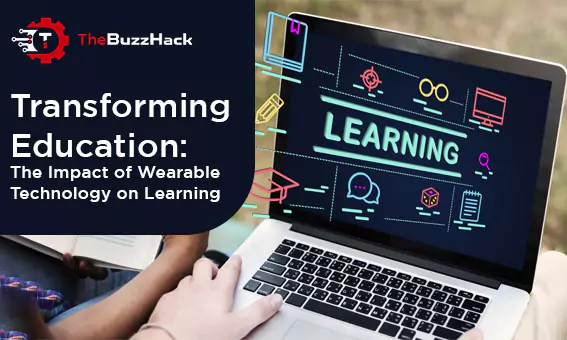
TRANSFORMING EDUCATION: THE IMPACT OF WEARABLE TECHNOLOGY ON LEARNING
In the ever-changing world of education, technology has made a significant impact by changing the way we teach and learn. A recent and highly promising development in this field is wearable technology. This technology has the potential to completely transform the education experience, making it more interesting, interactive, and effective. In this blog, we’ll look into how wearable technology is influencing education, its practical uses, and the crucial role played by Wearable App Development Services and developers in shaping this exciting future.
Let’s delve into the top benefits and see how they can help both learners and educational institutions. Join us for an in-depth exploration of the details we need to know about this technology.
The Growing Influence of Wearable Technology in Education
Wearable technology, which includes devices like smartwatches, fitness trackers, augmented reality glasses, and even smart clothing, has become increasingly popular in recent years. These devices are no longer limited to health and fitness; they have found their way into the field of education, offering new opportunities for both students and educators.
Learning with Wearables
Using wearable technology for learning in education comes with numerous advantages. One of the most significant benefits is the ability to customize learning experiences. Wearables can monitor and analyze student data in real time, providing insights into individual learning patterns, strengths, and weaknesses. This information allows educators to adapt their teaching methods to suit each student’s unique needs, ensuring a more effective and efficient learning process.
For example, smart glasses with augmented reality technology can deliver real-time information, like historical facts or mathematical equations, directly to a student’s field of vision. This interactive approach not only improves retention but also deepens understanding of the subject matter.
Developing Wearable Software
To fully harness the potential of wearable technology in education, it is crucial to develop specialized software. Wearable app development services play a crucial role in creating applications that cater to the specific needs of the education sector.
Wearable app developers focus on designing and developing applications that work well with various wearable devices. These applications can range from interactive language learning tools to virtual science experiments. Their goal is to create user-friendly, engaging, and educational experiences that take full advantage of the capabilities of wearable devices.
Wearable App Development Services
Numerous wearable app development companies have emerged to meet the increasing demand for wearable app development services. Software development companies offer a range of services to help you achieve your desired solutions.
Let’s explore each of these services:
- Ideation and Conceptualization: Collaborating with educational institutions and organizations to identify their specific needs and goals for wearable applications.
- Design and Development: Creating user interfaces that are user-friendly and visually appealing, ensuring that the app’s features align with educational objectives.
- Testing and Quality Assurance: Conducting thorough testing to identify and resolve any bugs or issues, ensuring a smooth user experience.
- Integration: Ensuring that the wearable application can seamlessly connect with other educational platforms and systems.
- These services offer effective solutions for businesses and organizations seeking to leverage wearable technology for their educational needs.
The Impact and Benefits of Wearable Technology in Education
In this discussion, we’ll explore how wearable technology is making a difference in education. If you’re considering working with wearable app developers, they can assist your educational institution in finding the right solutions.
- Enhanced Student Engagement: Wearable devices are changing how students learn, making it more interactive and exciting. Students can engage with their learning materials in a more hands-on way, like through fun games or immersive virtual reality experiences.
- Personalized Learning: Wearable tech allows for customized learning experiences. Students can learn at their own pace and receive tailored feedback and recommendations that help them grow academically.
- Accessibility: Wearable technology is helping students with disabilities by providing tools like speech recognition, instant language translation, and braille displays. This makes education more inclusive and accessible to everyone.
- Support for Teachers: Wearable devices also benefit teachers by providing insights into classroom dynamics. They can identify students who may be struggling and manage their classrooms more efficiently.
- Skill Development: Wearable devices are handy for skill development, whether it’s learning a new language or mastering a musical instrument. They offer real-time guidance and feedback, making it easier for students to progress in their chosen areas of skill development.
Challenges and Considerations in Wearable Technology for Education
In this discussion, we’ve covered everything you should be aware of when it comes to developing wearable software for education or implementing wearable technology solutions. Let’s go through these key points to understand what’s important for everyone. While the potential of wearable technology in education is significant, there are some challenges and factors to consider:
- Cost: Wearable devices can be quite expensive, making it difficult to ensure equal access for all students.
- Privacy and Data Security: When collecting and storing student data using wearables, it’s crucial to handle it with the utmost care to protect privacy and comply with data security regulations.
- Teacher Training: Educators require proper training to effectively incorporate wearable technology into their teaching methods.
- Content Quality: The success of wearable applications depends on the quality of educational content and how well it aligns with curriculum standards.
- These are the essential points to keep in mind if you’re looking to make the most of wearable technology in your organization. By understanding these factors and working on effective solutions, you can improve and provide your target audience with the best educational experiences.
Conclusion
Wearable technology is poised to revolutionize the field of education, offering a multitude of benefits for both learners and educational institutions. The growing influence of wearable technology in education is undeniable, with devices like smartwatches, fitness trackers, augmented reality glasses, and smart clothing finding their way into the learning environment. These devices have the potential to customize learning experiences, providing real-time insights into individual learning patterns and allowing educators to adapt their teaching methods for maximum effectiveness.
To fully unlock the potential of wearable technology in education, the role of wearable app development services and developers is paramount. These professionals are essential for designing and developing applications that cater to the unique needs of the education sector, creating user-friendly, engaging, and educational experiences that leverage the capabilities of wearable devices.
Wearable app development services encompass a range of crucial activities, including ideation and conceptualization, design and development, testing and quality assurance, integration with educational platforms, and continuous updates and maintenance. These services offer effective solutions for educational institutions seeking to harness wearable technology for their specific needs.
The impact and benefits of wearable technology in education are substantial, ranging from enhanced student engagement through interactive learning experiences to personalized learning that caters to individual student needs. Wearable technology also contributes to increased accessibility for students with disabilities and provides valuable support for teachers in managing classrooms and identifying struggling students. Additionally, wearable devices assist in skill development by offering real-time guidance and feedback in various educational areas.
However, it is essential to acknowledge and address the challenges and considerations associated with wearable technology in education. These include the cost of wearable devices, privacy and data security concerns, the need for teacher training, and the quality of educational content. By understanding and working on effective solutions to these challenges, educational institutions can provide their students with the best possible learning experiences while harnessing the full potential of wearable technology in education. In this dynamic landscape, wearable technology stands as a promising tool for transforming the future of education, making it more engaging, inclusive, and effective for all.
Read More: HOW TO PROTECT YOUR WORDPRESS WEBSITE AGAINST DDoS ATTACKS


